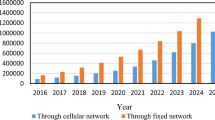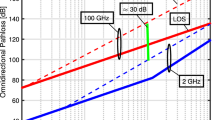Abstract
Cooperative communication using multiple relays improves quality of service (QoS) parameters of a communication system. To verify this improvement, accurate analysis must be done considering the various fading channels and probability density function (PDF) or cumulative distribution function (CDF) of signal-to-noise ratio (SNR) in relays and destination. In this paper, using the moment-generating function (MGF) method and considering Nakagami-m fading channel, the outage probability and effective capacity are analyzed. Obtaining the closed-form expression of outage probability and effective capacity in Nakagami-m fading channel includes complex mathematical calculations; thus, the Rayleigh fading channel is assumed to be a special case of Nakagami-m distribution to achieve simpler mathematical equations. Simulation results verify the mathematical analysis in terms of effective capacity and outage probability.




Similar content being viewed by others
References
Al-Tous H, Barhumi I (2016) Resource allocation for multiple-sources single-relay cooperative communication OFDMA systems, in IEEE Transactions on Mobile Computing 15(4):964–981
Cerutti I, Fumagalli A, Gupta P (2008) Delay models of single-source single-relay cooperative ARQ protocols in slotted radio networks with Poisson frame arrivals, in IEEE/ACM Transactions on Networking 16(2):371–382
El-Keyi A, Champagne B (2010) Adaptive linearly constrained minimum variance beamforming for multiuser cooperative relaying using the Kalman filter. IEEE Trans Wirel Commun 9(2):641–651
Sousa DA, Alexandre C, Fernandes R, Estevao C, Fernandes R (2016) Outage and SER analysis of DF cooperative OFDM systems with nonlinear power amplifiers. AEU – international Journal of Electronics and Communications 70(9):1329–1338
Tran VC, Le MT, Tran XN, Duong TQ (2015) MIMO cooperative communication network design with relay selection and CSI feedback. AEU - International Journal of Electronics and Communications 69(7):1018–1024
Gatera O, Ilhan H, Kayran AH (2016) A novel LMS-BLM algorithm for AF relays based cooperative wireless networks. AEU - International Journal of Electronics and Communications 70(11):1480–1488
Gautam S, Lagunas E, Sharma SK, Chatzinotas S, Ottersten B (2017) Relay selection strategies for SWIPT-enabled cooperative wireless systems. In: IEEE 28th Annual International Symposium on Personal, Indoor, and Mobile Radio Communications (PIMRC). Montreal, QC, Canada, pp 1–7. https://doi.org/10.1109/PIMRC.2017.8292374
Zahedi A, Lari M, Albaaj A, Alabkhat Q (2017) Simultaneous energy harvesting and information processing considering multi-relay multi-antenna using maximum ratio transmission and antenna selection strategies. Trans Emerging Telecommunications Technologies 28. https://doi.org/10.1002/ett.3182
Han L, Mu J, Wang Y, Gao J (2017) Performance analysis of multi-hop full-duplex decode-and-forward relaying. Ad Hoc Netw 58:247–254
Yeoh PL, Elkashlan M, Collings IB (2011) Selection relaying with transmit beamforming: a comparison of fixed and variable gain relaying, in IEEE Transactions on Communications 59(6):1720–1730
Jabi M, Szczecinski L, Benjillali M (2011) “Outage probability of diversity combining receivers in arbitrarily fading channels,” Cornell university. arXiv 1105:4340 vol. abs/1105.4340
Modi B, Annamalai A, Olabiyi O, Palat RC (2012) Ergodic capacity analysis of cooperative amplify-and-forward relay networks over rice and Nakagami-m fading channels. Int J Wireless Mobile Networks (IJWMN) 4(1)
Lan L, Xie L, Chen H (2014) On outage probability analysis of uplink in land mobile satellite cooperative system. In: 2014 Sixth International Conference on Wireless Communications and Signal Processing (WCSP). Hefei, China, pp 1–6. https://doi.org/10.1109/WCSP.2014.6992095
Zhao Y, Xie L, Chen H, Wang K (2017) Ergodic channel capacity analysis of downlink in the hybrid satellite-terrestrial cooperative system. Wirel Pers Commun 96(3):3799–3815
Zhao Y, Adve R, Lim TJ (2005) Outage probability at arbitrary SNR with cooperative diversity, in IEEE Communications Letters 9(8):700–702
Kumar N, Bhatia V, Dixit D (2017) Performance analysis of QAM in amplify-and-forward cooperative communication networks over Rayleigh fading channels. AEU-International Journal of Electronics and Communications 72:86–94
Torabi M, Ajib W, Haccoun D (2009) "Performance analysis of amplify-and-forward cooperative networks with relay selection over Rayleigh fading channels," VTC Spring 2009 - IEEE 69th Vehicular Technology Conference, Barcelona, Spain, Apr. , pp. 1–5, doi: https://doi.org/10.1109/VETECS.2009.5073774
Kumar N, Bhatia V (2016) Outage probability and average channel capacity of amplify-and-forward in conventional cooperative communication networks over Rayleigh fading channels. Wirel Pers Commun 88(4):943–951
Gaber AH, Ismail MH, Mourad HAM (2013) Outage probability analysis of cooperative diversity networks over Weibull and Weibull-lognormal channels. Wirel Pers Commun 70(2):695–708
Modi B, Annamalai A, Olabiyi O, Palat R (2015) Ergodic capacity analysis of cooperative amplify-and-forward relay networks over generalized fading channels. Wirel Commun Mob Comput 15(8):1259–1273
Chen C, Shu M, Wang Y, Yang M, Zhang C (2016) Outage probability of MRC for κ-μ shadowed fading channels under co-channel interference. PLoS ONE 11(11):e0166528
Yilmaz AO (2011) Calculating outage probability of block fading channels based on moment generating functions. IEEE Transactions on Communications 59(11):2945–2950
Dwivedi VK, Singh G (2014) Moment generating function based performance analysis of maximal-ratio combining diversity receivers in the generalized-K fading channels. Wirel Pers Commun 77(3):1959–1975
Peppas KP, Mathiopoulos PT, Yang J (2016) On the effective capacity of amplify-and-forward multihop transmission over arbitrary and correlated fading channels. IEEE Wireless Communications Letters 5(3):248–251
Zhang J, Tan Z, Wang H, Huang Q, Hanzo L (2014) The effective throughput of MISO systems over κ − μ fading channels. IEEE Trans Veh Technol 63(2):943–947
Al-Hmood H, Al-Raweshidy HS (2018) Effective throughput of MISO systems over κ−μ shadowed fading channels: MGF based analysis. arXiv 1804.10991, Cornell university
Zhang J, Dai L, Gerstacker WH, Wang Z (2015) Effective capacity of communication systems over κ–μ shadowed fading channels, in Electronics Letters 51(19):1540–1542
Khan I, Rajatheva N, Tanoli SA, Jan S (2014) Performance analysis of cooperative network over Nakagami and Rician fading channels. Int J Commun Syst 27(11):2703–2722
Larsson P, Gross J, Al-Zubaidy H, Rasmussen LK, Skoglund M (2016) Effective capacity of retransmission schemes: a recurrence relation approach. IEEE Trans Commun 64(11):4817–4835
Kanellopoulou KD, Peppas KP, Mathiopoulos PT (2018) "Effective capacity analysis of equal gain diversity combiners over generalized fading channels," 2018 IEEE 87th vehicular technology conference (VTC spring), Porto, Portugal, pp 1–5, Jun. 2018
Kanellopoulou KD, Peppas KP, Mathiopoulos PT (2017) Effective capacity of Lp -norm diversity receivers over generalized fading channels under adaptive transmission schemes. arXiv preprint arXiv 1703:06941
F. Yilmaz, M-S. Alouini, “A novel and unified approach for averaged channel capacity and averaged effective capacity analyses of diversity combining and multihop transmission schemes in flat fading environments”, Turkish Journal of Electrical Engineering and Computer Science, vol. 27, issue 1, pp. 106–119, 2019
Yang G, Xiao M, Pang Z (2018) Delay analysis of traffic dispersion with Nakagami-m fading in millimeter-wave bands. IEEE Wireless Communications and Networking Conference (WCNC), Barcelona, Spain
Simon MK, Alouini MS (2000) “Digital communication over fading channels, a unified approach to performance analysis” John Wiely & Sons, New York
I. S. Gradshteyn and I. M. Ryzhik. “Table of integrals, series, and products. Academic Press,” 7th edition, 2007
Simon MK, Alouini MS (2005) “Digital communication over fading channels” John Wiley & Sons. Inc, New York
Hasna M, Alouini M (2004) Harmonic mean and end-to-end performance of transmission system with relays. IEEE Trans Communications 52(1):130–135
da Costa DB, Aissa S (2009) Cooperative dual-hop relaying systems with beamforming over Nakagami-푚 fading channels. IEEE Trans Wirel Commun 8(8):3950–3954
Soret B, Torres CA, Entrambasaguas JT (2010) Capacity with explicit delay guarantees for generic source over correlated Rayleigh channel. IEEE Trans Wirel Commun 9(6):1901–1911
Zahedi A (2019) Optimum beam forming in selective-relay cooperative communication using effective capacity approach. AEU-International Journal of Electronics and Communications 98:199–207
Author information
Authors and Affiliations
Corresponding author
Additional information
Publisher’s note
Springer Nature remains neutral with regard to jurisdictional claims in published maps and institutional affiliations.
Rights and permissions
About this article
Cite this article
Zahedi, A. Effective capacity and outage analysis using moment-generating function over Nakagami-m and Rayleigh fading channels in cooperative communication system. Ann. Telecommun. 75, 193–200 (2020). https://doi.org/10.1007/s12243-019-00739-1
Received:
Accepted:
Published:
Issue Date:
DOI: https://doi.org/10.1007/s12243-019-00739-1




